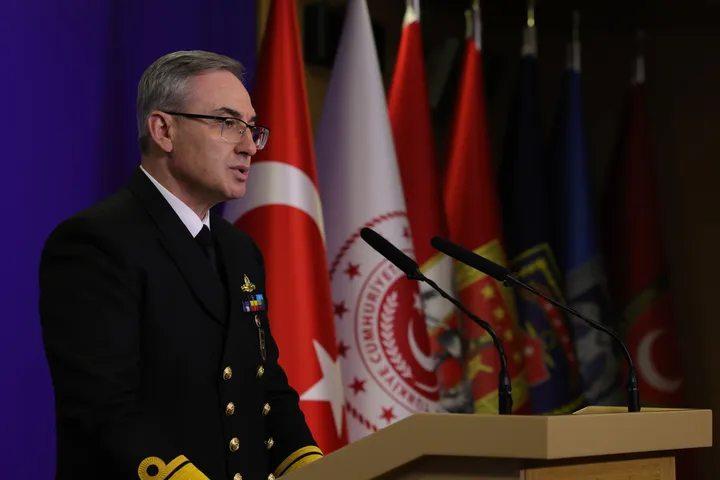Maps plastered on the walls all around have big red circles pointing out the disaster zones.
Phones are ringing constantly and there is a cacophony of overlapping chatter as conversations flow in several different languages.
This one-room unit has been set up in a container on the outskirts of Kahramanmaras city, one of the areas devastated in the February 6 twin temblors that have claimed more than 35,000 lives in southeastern Türkiye.
The UN centre, run in close coordination with the Turkish Disaster and Emergency Management Presidency (AFAD), was up and running just a day later, tasked with the crucial job of supervising the dozens of international teams that flew into the country to help in search and rescue efforts.
From inside this container, people have been managing at least 30 teams from around 28 countries working in Kahramanmaras.
Founded in 1991, the UN-led International Search and Rescue Advisory Group, or INSARAG, is described as a network of disaster-prone and disaster-responding countries and organizations dedicated to urban search and rescue and operational field coordination.
Manages planning, operations, and logistics
Led by a Singaporean official Nizam, the centre in Türkiye has at least five INSARAG-trained people managing front, registration, planning, operations, and logistics desks. The coordination team also includes young Turkish assistants for translation and other critical local insights.
Nizam, an UN-trained official with 25 years of service, told Anadolu that 18 foreign teams had left the southern province by Tuesday evening after weeklong search and rescue operations.
“Due to the unified and collective efforts of all our international teams, we were able to rescue 115 survivors,” he said.
READ MORE: The tech helping save lives after Türkiye’s deadly earthquakes
Teams ought to be self-sufficient
By Tuesday, international teams had also recovered more than 1,000 bodies from the rubble of destroyed buildings.
According to Türkiye’s Foreign Ministry, 9,315 personnel from 80 nations had arrived in the country until Monday – exactly a week since the disaster struck – to help out in disaster zones in Hatay, Gaziantep, Adiyaman, Malatya, and Kahramanmaras.
The INSARAG unit has been working around the clock since February 7, receiving international teams, helping them set up, and coordinating with AFAD on their forward deployment.
“The deployment of international teams is done on a needs-based assessment, which also depends on the capacity of the international teams,” Nazim explained, gesturing to areas marked on the maps hanging above desks cluttered with computers, headsets, and documents.
The coordination team has two meetings every morning at 0330GMT) and 0600GMT, he said.
“During these meetings, we check our capacity, coordinate with AFAD, and prepare our schedules for deployment of the teams,” explained the Singaporean official, who also worked during the 2018 Indonesia earthquake and catastrophic Indian Ocean tsunami in 2004.
“Our priority is to save more lives and that means highly trained teams are sent to places where we get information that people may be trapped,” he added.
Asked about what international teams need most for successful operations in disaster-hit areas, Nazim instantly replied: “self-sufficiency.”
“A team has to be self-sufficient,” he said, adding that they have to be fully equipped with the required tools, food, medicines, and any other supplies.
READ MORE: Live updates: Sensational rescues as more people pulled alive on 10th day
“We do not want to be a burden on the host country which is already battling a disaster. Being self-sufficient is the first requirement for any team,” he reiterated.
His own team, he said, has been operating in shifts and sleeping in the same container where they work.
Nazim said international teams are deployed on the basis of their capacity, categorized as “heavy, mid, and light.”
“The heavy team if fully equipped, includes canines and cutting and breaking tools, while the mid-level team may or may not have canines along,” he said.
“The light category teams just have basic search and rescue equipment,” he added.
All of Nazim’s team members are from Singapore, barring one from Belarus who manages logistics.
“This is the 20th overseas deployment mission for Singaporean officials to coordinate disaster response efforts,” he said, praising his colleagues' “good communication and coordination skills.”
READ MORE:Türkiye quakes 'exceptional natural phenomenon': President Erdogan
'Pancake collapse of buildings'
Communication is usually the first casualty of any disaster but it “does not have an impact” on teams like the one led by Nazim.
“INSARAG has its own communications system which is independent of any local communications system,” he told Anadolu.
After the earthquakes, mobile and internet services were temporarily affected in Kahramanmaras and other disaster zones, but have since been restored.
“We use INSARAG Coordination Management System, or ICMS, and all international teams are registered with it and have online accounts,” the official explained.
Teams log into the system before flying to a disaster area to get connected for deployment and coordination, he added.
“We also have satellite phones and our own Wi-Fi system, besides WhatsApp groups for instant messaging,” he said.
On the scale of the disaster, Nazim said it is “widespread.”
“We are responding to the biggest (in recent times) in terms of damages done due to the pancake collapse of buildings,” he emphasised.
READ MORE: Here's how to help Türkiye and Syria earthquake victims
























